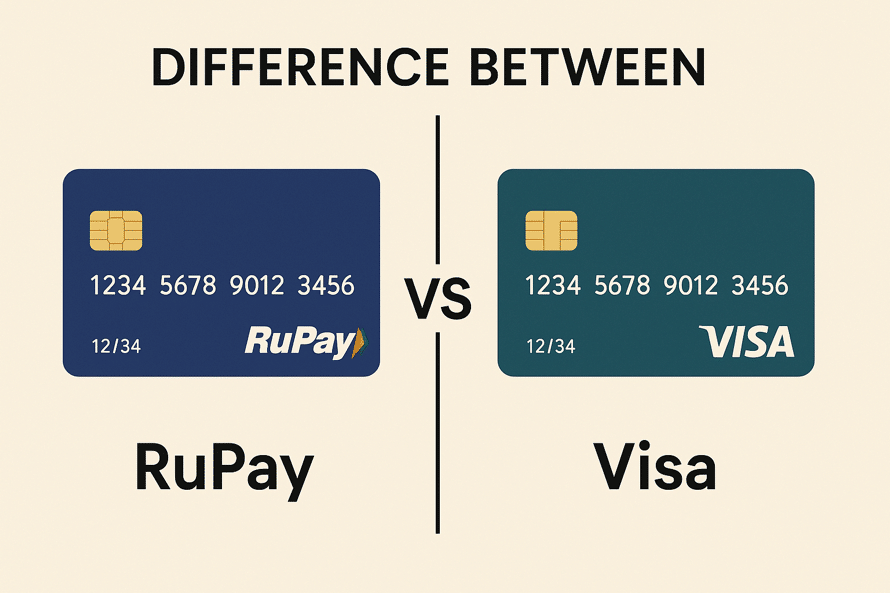
As India’s economy continues to grow at a steady pace, its financial services sector is undergoing tremendous changes. Increasingly, people are opting to pay with cards instead of cash. Consumers often get confused when choosing between RuPay and Visa for a new card.
In this blog post, we’ll discuss RuPay and Visa card, including some of the main differences between them and suggest which one might be better for you.
Introduction to Card Payment Networks
Payment cards have become an integral part of daily financial activities, thanks to the increasing number of online transactions. Debit and credit cards are widely used today for secure, traceable financial transactions, as well as convenience.
A complex system referred to as a card payment network is the one that acts behind the mere act of tapping or swiping. Two such networks are RuPay and Visa, both of which play a critical role in India. Although they serve the same purpose, they differ in several key areas, including ownership, reach, and fees.
What is a Card Network?
A card network links the merchant’s bank and the cardholder’s bank. The network forwards the request, checks the payment details, and allows settlement as soon as a transaction begins. These networks define charge schedules, set transaction rules, and ensure secure communication between banks and retailers. These networks facilitate safe and effective card-based payments.
Role of Card Networks in Digital Transactions
For digital payments to be safe and easy, card networks are essential. RuPay and Visa card networks regulate the resolution of disputes, fraud tracking, and approval of transactions, along with ensuring cash availability. In effect, they offer a solid infrastructure for card usage within the country and abroad to allow users to shop securely, pay securely, and withdraw cash securely.
Overview of RuPay Card
RuPay serves as an Indian card payment network designed to boost domestic financial inclusion and reduce reliance on international systems. It offers safe, effective, and reasonably priced debit, credit, and prepaid transaction services.
Origin and Development by NPCI
The RuPay card payment system was launched in India by the National Payments Corporation of India (NPCI). RuPay aims to make the financial system more accessible to everyone and less reliant on international card networks. It was created as part of a broader initiative to help India achieve greater financial independence and self-sufficiency.
Types of RuPay Cards (Debit, Credit, Prepaid)
RuPay provides prepaid, credit, and debit card options. These are often used for cash withdrawals, online shopping, and in-person transactions, and they may be connected to current or savings accounts. The selection of RuPay cards has grown over time to accommodate government, business, and individual programs.
Domestic Focus and Government Support
Domestic use is the main emphasis of RuPay. Government programs like the Jan Dhan Yojana use RuPay cards to provide impoverished communities with basic financial services. The connection with government subsidies and digital financial literacy initiatives further strengthens its appeal across various socioeconomic levels.
Overview of Visa Card
Visa is a global card payment network that is renowned for its advanced features and broad international acceptance. Both RuPay and Visa card networks facilitate safe debit, credit, and prepaid card transactions in several nations.
Global Card Network and Reach
Visa is a global financial services firm that runs one of the world’s biggest electronic payment networks. Online shoppers and foreign tourists alike love using Visa thanks to its robust infrastructure and broad acceptance. Visa makes it easy to pay for things across the world.
Types of Visa Cards (Classic, Platinum, Signature)
There are many Visa card tiers, including Classic, Platinum, and Signature, each with progressively more perks. These cards, which come with travel and leisure benefits as well as cashback and reward points, may be issued as debit or credit cards. For high-end customers, several cards even include concierge services and insurance.
Global Merchant Acceptance and Services
Visa’s widespread acceptance is one of its most significant benefits. A wide range of online platforms, ATMs, and retailers accept it. Because of its wide range of applications, Visa is beneficial for those who travel overseas or make international payments regularly.
Key Differences Between RuPay and Visa
Selecting the best card for your requirements requires understanding the differences between RuPay and Visa cards. The following are a few critical areas of differentiation.
Ownership and Management
The Reserve Bank of India oversees NPCI, an Indian organization that manages RuPay. Visa, the world’s largest payment processor, is an international private company with its headquarters located in the United States. This basic distinction shapes their rules, fees, and areas of operation.
Geographic Scope (Domestic vs Global)
To meet the needs of Indian customers, RuPay primarily works within India. Visa, on the other hand, is more adaptable for usage worldwide because of its worldwide reach and support for transactions in many nations.
Transaction Processing Speed
RuPay says its domestic routing system allows for quicker processing rates inside India. Despite their efficiency, Visa transactions are processed via international servers, which might cause minor delays in comparison to local processing.
Cost and MDR Charges
Smaller businesses and government initiatives find RuPay more appealing because of its often cheaper Merchant Discount Rate (MDR) and transaction costs. MDR for RuPay and Visa card transactions differ, with Visa often charging more, particularly for premium cards with additional services.
Security Features and Customer Protection
Both networks have robust fraud prevention and encryption mechanisms. Visa is the world’s largest payment processor and has a more comprehensive worldwide fraud detection system. RuPay is catching up quickly, particularly when it comes to safe domestic transactions and secure authentication methods like two-factor verification.
International Usage and Forex Charges
For international transactions, Visa certainly works better than RuPay. In contrast to RuPay, which is only used in countries with specific partnerships, it is accepted on a wide range of platforms and nations. Visa often offers dynamic currency conversion; however, forex fees might also vary.
Pros and Cons of RuPay Cards
For domestic users, RuPay cards provide several benefits, including quick processing and low transaction fees. Unlike worldwide card networks, they offer fewer premium features and restricted international acceptance.
Low Cost and Faster Settlement
RuPay’s minimal fees and quick transaction processing, especially in India, are its main advantages. Compared to RuPay and Visa card networks, RuPay’s domestic credentials enable near-real-time or real-time financial transactions, which is advantageous to both users and merchants.
Limited International Acceptance
RuPay is not widely accepted worldwide despite its increasing popularity. For people who travel regularly or make transactions internationally, this can be a drawback. Although there are partnerships with international networks, their scope is still inferior to Visa’s.
Integration with Jan Dhan and UPI
RuPay cards work effectively with government welfare schemes like the Jan Dhan Yojana. This integration promotes broader financial inclusion by providing low-income groups and digital-first users with a smooth experience. Over 300 million RuPay debit cards have been issued under the Pradhan Mantri Jan-Dhan Yojana, contributing to this development.
Pros and Cons of Visa Cards
Visa cards offer several premium perks, especially for travelers, and enjoy global recognition. However, they may not be as economical for domestic usage and sometimes come with higher transaction costs.
Widely Accepted Globally
Visa is the most widely accepted globally. A Visa card ensures seamless transactions, whether you travel abroad or shop online from a foreign website. Additionally, Visa provides worldwide customer service and supports several currencies, making it a strong option compared to RuPay and Visa card choices.
Higher Transaction Charges
There are several disadvantages associated with Visa cards, one of which is the increased transaction costs, especially for merchants. Often, these are passed on to customers through higher charges or lower discounts.
Advanced Features and Travel Benefits
More benefits for travel are available with Visa cards, including insurance coverage, access to concierge services, and the use of airport lounges. Frequent travellers and heavy spenders appreciate these perks.
Which One Should You Choose?
There are certain personal and financial aspects to consider between RuPay and a Visa card. The options below can help you make a decision.
Based on Usage Pattern (Domestic vs. International)
A RuPay card can be a better and cheaper choice if you do most of your shopping in India. Visa is accepted worldwide and comes with additional travel benefits, making it the ideal choice for those who conduct a lot of business abroad.
Charges and Bank Preferences
Both are made available at most banks, but with different charges, points, and rewards depending on the agreements your bank has with other companies. It is a good idea to review the reward programs and charge structure first before making a decision.
Security and Customer Support
Although both networks have strong security features, Visa offers more comprehensive customer service and assistance in tackling international fraud. For domestic consumers who want simpler dispute resolution and support for local languages, RuPay is perfect.
Conclusion
RuPay and Visa cards both facilitate digital transactions, but their unique features make them suitable for specific requirements. RuPay is quick, affordable, and inclusive for local customers, while Visa offers a worldwide reach, premium benefits, and enhanced security.
Consider your usage patterns, such as whether you travel frequently, shop overseas, or generally transact in India, to make a more informed choice. Your financial habits, banking preferences, and service expectations should guide your choice. However, many value having both cards to cover all bases.
FAQs
Q. Can RuPay be used internationally like Visa?
Although RuPay has several international collaborations, its primary usage is domestic. Visa cards are better suited for international transactions because they enjoy global recognition.
Q. Which card has lower transaction fees – RuPay or Visa?
RuPay often offers reduced transaction costs. This is because of its domestic processing and government-supported programs, particularly in India.
Q. Is RuPay safer than Visa?
Both cards adhere to international standards and are safe. While RuPay is relatively safe for local transactions and conforms closely to Indian banking rules, Visa has a more extended history of preventing fraud worldwide.
Q. What banks offer RuPay and Visa cards in India?
In India, the majority of significant public and commercial banks provide both RuPay and Visa cards. Customer preferences and account types may impact availability.
Q. Can I use both RuPay and Visa cards together?
Yes, you can use and hold both Visa and RuPay cards. With this combination, you may take advantage of Visa’s global acceptability and RuPay’s low-cost local benefits.




